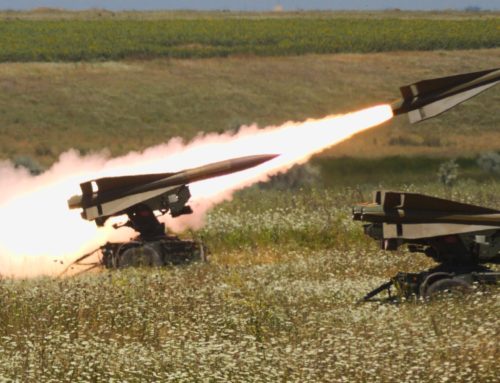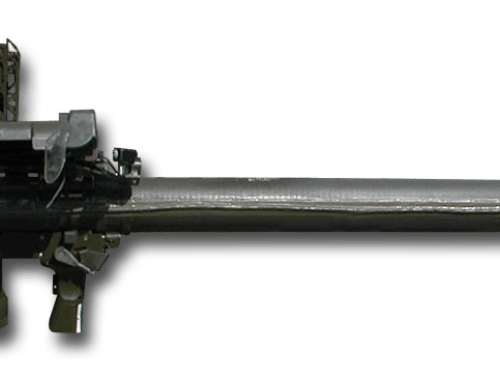A Brief History of the MIM-104 “Patriot”
The Patriot’s history dates back to 1961 when the US Army Missile Command conceptualised the idea of a mobile air defense system utilising missiles for interception. Development began in 1965 with the “SAM-D” project and test launches began in 1970. Full scale engineering development began in 1976 and the system gained the “Patriot” designation. By 1985 the system was declared fully operational within the US Army. The Patriot system has received a number of updates with the most major midlife updates being PAC-1 through PAC-3 (Patriot Advanced Capability). PAC-1 introduced in 1988 allowed Patriot to engage short range ballistic missiles.
It’s successor PAC-2 featured further software updates and improvements to the blast fragmentation warhead, and would come in handy during the first Gulf War (1991) where Iraqi SCUD missiles threatened the coalitions ability to effectively intervene in the crisis. Patriot PAC-2 batteries were deployed to the front line and other partner nations to mitigate the threat posed by Iraqi SCUD missiles. PAC-2 was further upgraded using the lessons learned during the Gulf War (1991) and the army began the development of the Guidance Enhanced Missile (GEM) as a stop-gap while the PAC-3 interceptor program developed. The GEM’s main features were a new radar seeker head with increased capability against low RCS targets and an enhanced proximity fuze for use against high speed ballistic missiles. The GEM also received updates during its lifespan; the GEMC, GEMT and finally the GEM+. The GEMC was a variant of the standard GEM except with a flight and guidance profile that was more suited to engaging cruise missiles, hence the name GEM – C (Cruise missile). Similarly the other variant, the GEM-T, was specifically designed to counter “Theatre Launched Ballistic Missiles”. TLBMs are a group of ballistic missiles with a range of less than 3,500Km (or roughly 2174.799 miles/1889.849 nautical miles for those so inclined). The GEM+ was simply a hardware and software update of the older GEM missiles with older components being replaced and a further enhancement to the proximity fuze and seeker head were introduced. The GEM+ entered service in 2002.

Finally (god this took ages to research and write) PAC-3 was introduced in 2001 and declared operationally ready in 2002. The PAC-3 is considered the most substantial update to the patriot system since its conception. The most fundamental change is to the method of intercept used by the missiles. The PAC-3 compliant missiles operate on a “hit to kill”interception method – not a proximity detonation. This interception method involves the interceptor directly “hitting” the target – hence the “hit to kill” designation. This meant that the new missile was smaller and faster than previous iterations of the Patriot interceptors. This particular interceptor traces its development to the Extended Range Interceptor (ERINT) program which competed with an upgraded PAC-2 missile called Multi Mode Seeker (MMS) program. In 1994, the Acquisition Review Council that the ERINT would be used as the missile for the PAC-3 upgrade program – due to its greater range and accuracy. The PAC-3 system was deployed in the Second Gulf War in 2003 and was very successful in the conflict, achieving a 2 for 2 intercept rate against Iraqi SCUD missiles, nine other interceptions were carried out by the older PAC-2 systems giving them a 9 for 9 intercept rate. The PAC-3 system did not engage another 6 SCUDs as they were deemed to be on course to impact non-threatening areas (unoccupied areas). Unfortunately during the 2003 Gulf War, patriots were involved in several friendly-fire incidents, downing a USN F18C (alleged), a RAF Tornado (killing both aircrew) and a USAF F16 was fired on but not destroyed. There have been some upgrades to the PAC-3 system, the most notable being the Missile Segment Enhancement (MSE) program. This program was developed to enhance the range of the Patriot system with a two stage rocket motor being added, larger control fins and enhanced support systems. This effectively doubled the range of the missile. The US Army received the first MSE equipped missiles in 2015. The PAC-3 system has also been integrated into the Link 16 data sharing system allowing for superior situational awareness to be obtained by the Patriot crew and for better target discrimination to hopefully prevent further “blue on blue” (friendly fire) events.
The System has been widely exported to partner nations such as; Germany, Greece, Israel, Japan, Kuwait, the Netherlands, Poland, Qatar, Saudi Arabia, South Korea, Spain, Taiwan, UAE, and USA.
The System
While the history section has covered a broad overview of the Patriot system itself, here we will examine the components with our understanding now clarified by the introduction. The Patriot is a modular system, much like the SA-10, and consists of the following components.
- A Launcher Electronics Module (LEM) – the brain of the patriot system
- A Datalink Terminal Module (DLTM) – the communications section of a launcher – allows for radio digital data link between launcher and remote engagement station.
- A Generator – provides power to the launcher and its associated systems.
- A Data Link Mast Assembly – the ears of the launcher transmits and receives DL communications.
- A Launcher Missile Round Distributor – passes commands received to missiles and allows for remote launch.
- Missile Launch Tube Canister – 4 canisters per launcher and 4 missiles per canister giving a total of 16 missiles per launcher.

All of these systems work in conjunction autonomously. This allows the Patriot system to be completely autonomous, the only human interaction required is to provide launch authority when a target is picked out. This is provided from the human crew of usually 3 to 4 from the Engagement Control Center (ECS).
The AN/MSQ 104 ECS is the only manned portion of the Patriot system. The ECS contains two computer consoles that depict radar targets as symbols on the screens. The crew consists of a Tactical Control Officer or TCO (right console), a Tactical Control Assistant or TCA (left console) and a Communications Operator (back of the ECS). The TCA usually does the ‘firing’ of the missile and the TCO passes on valid targets and ensures friendly forces are not engaged. The Communications Officer monitors all communications between headquarters and the Patriot batteries.
The Radar
The Patriot system utilizes a series of three radars, one main phases array antenna and two smaller antennas. The main array is the is the AN/MPQ-53 Phased Array radar. The AN/MSQ-53 was a radical departure from standard “constant beam” radar. Very simply the phased array emits a rapid and random radar beam thousands of times per second, this makes it exceptionally hard to jam, and allows for an extremely high refresh rate on the radar picture. The PAC-3 configuration included an upgraded radar system AN/MPQ-65 radar which significantly increases the detection ability in high clutter environments. A new (probably Gallium Nitrite Based) AESA radar system is reported to be in development for the Patriot system increasing the radar field of view from 120 degrees to 360 degrees, eliminating the need for the two smaller “blind spot” protection radars from the system, increasing the systems strategic mobility and increasing radar effectiveness in saturated environments and increasing the probability of detecting Low Observable aircraft.
In BMS the radar used with the Patriot system is the AN/MPQ-53. The radar has a Search and Acquisition Radar (SAR) and Fire Control Radar detection range of 77nm as the PESA radar does both tasks. Typical engagement range of the Patriot in game can be anywhere within 60nm. The radar has excellent counter ECM (ECCM) in BMS and has no stated burn through range leading the author to suspect that the radar is not “phased” by jamming (get it ;D). The radar also has exceptional ground clutter filters meaning that it has no minimum locking altitude in BMS, meaning that the only safe way to approach a Patriot site is to terrain mask.
The Missiles
Due to the fact that the Patriot system in BMS uses the AN/MPQ-53 radar, it is safe to assume that the missile is PAC-2 compliant and more than probably an analogue of the standard GEM missile. In reality this gives the missile a range of 70km (37.7nm) however, in BMS the pre-planned threat ring has a diameter of 50.0nm so it is safe to assume that you will be engaged as soon as you enter that threat ring. In BMS it is common for Patriots to fire multiple missiles at a single target, so even if one missile is successfully defeated, more are on the way to intercept the aircraft – this gives the patriot system a particularly high probability of kill (PK). This is further enhanced by the flight path taken by the PAC-2 missiles being a ‘Super Sonic Drop Down’ profile. This is where the missile approaches from above the target aircraft and dropping down on the target at ludicrous speed.

How to Defeat MIM-104 in BMS
Due to the Patriots PESA array the system will not provide you will a standardized launch warning from the RWR (a bit like launching an AMRAAM in TWS mode). Instead you will know you’re being fired on by a minute difference in RWR tone from the Patriot symbol. If you manage to detect this it means that the system is now guiding a missile(s) to your aircraft using the Track Via Missile (TVM) method of guidance. However, if you do not detect the Patriots engagement tone on the RWR, the first warning you will receive is a pitbull notification from the PAC-2 missile. The warning received will be a flashing M encompassed in a circle. If you are at high altitude when you receive this warning your options are hugely limited. The best option would be to jettison any stores you may be carrying (Emergency Jett advised) and execute a series of high G (8-9G) descending turns and deploy lots of chaff (and then pray). At lower altitude your options are less limited. Terrain masking is strongly advised additionally as the missile(s) may be lower to the horizon than it would be, this means you can execute a drag defense and dive cover provided by terrain masking.
How to Destroy MIM-104 in BMS
The best way to combat MIM-104 is to either deploy cruise weapons from a high standoff range with SEAD support or, to execute a terrain masked approach with a long range pop-up attack using fire and forget weapons if available, AGM-65 is ideal for this. Your main targets in both cases should be the AN/MPQ-53 PESA radar followed by the launchers then the support vehicles.

Quick Reference
- Rmax = 50nm
- Rmin = N/A
- AltMax = 79,500
- AltMin = N/A




